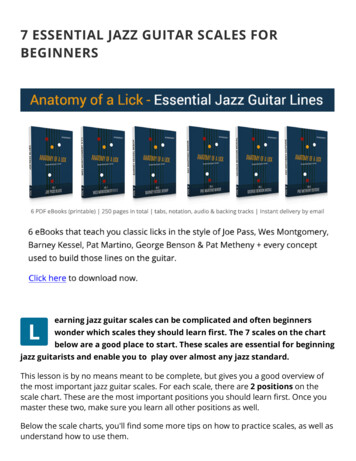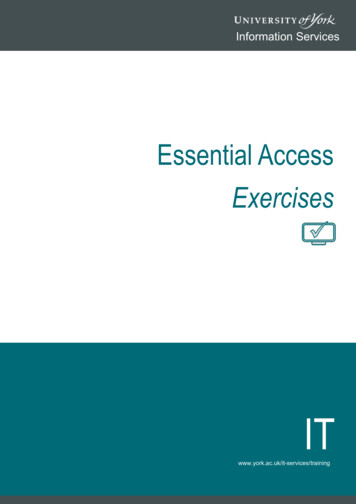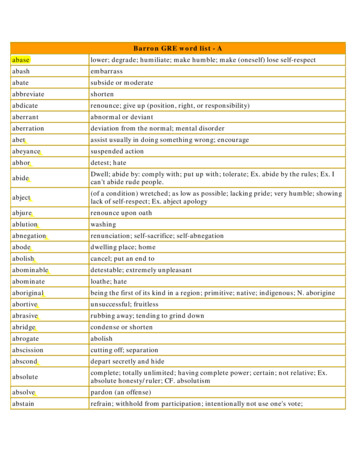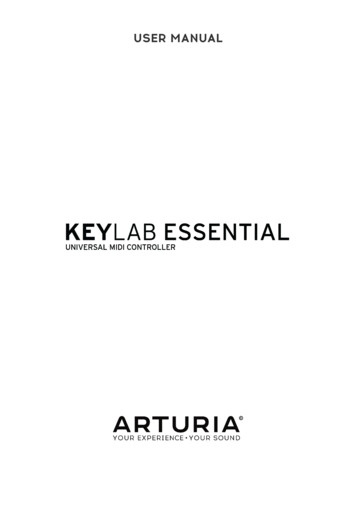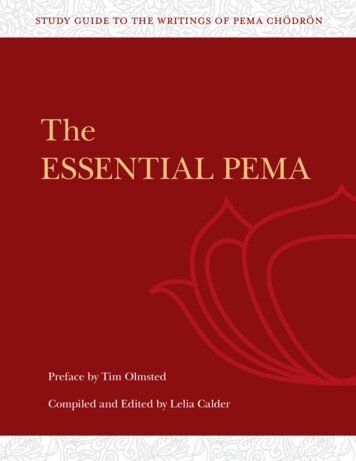
Transcription
STUDY GUIDE TO THE WRITINGS OF PEMA CHÖDRÖNTheESSENTIAL PEMAPreface by Tim OlmstedCompiled and Edited by Lelia Calder
THE ESSENTIAL PEMACONTENT (blue type denotes a link)Preface. . . . . . . . . . . . . . . . . . . . . . . . . . . . . . . . . . . . . . . . . . . . . . . . . . . . . . . . . . . . . . . . . . . . . . . . . . . . . . . . . . . . . . . . . . . . . . . . . . . . . . . . . . 3Acknowledgments. . . . . . . . . . . . . . . . . . . . . . . . . . . . . . . . . . . . . . . . . . . . . . . . . . . . . . . . . . . . . . . . . . . . . . . . . . . . . . . . . . . . . . . . . . . . . 4I. GROUND: Befriending Ourselves . . . . . . . . . . . . . . . . . . . . . . . . . . . . . . . . . . . . . . . . . . . . . . . . . . . . . . . . . . . . . . . . . . . . . . . . . 51. Buddha Nature – Basic Goodness. . . . . . . . . . . . . . . . . . . . . . . . . . . . . . . . . . . . . . . . . . . . . . . . . . . . . . . . . . . . . . 72. Three Kinds of Suffering and Four Noble Truths . . . . . . . . . . . . . . . . . . . . . . . . . . . . . . . . . . . . . . . . . . . . . . 83. Taking Refuge. . . . . . . . . . . . . . . . . . . . . . . . . . . . . . . . . . . . . . . . . . . . . . . . . . . . . . . . . . . . . . . . . . . . . . . . . . . . . . . . . . . . 104. Three Marks of Existence – Three Facts of Life. . . . . . . . . . . . . . . . . . . . . . . . . . . . . . . . . . . . . . . . . . . . . . 115. Maitri – Unconditional Friendliness Towards Oneself. . . . . . . . . . . . . . . . . . . . . . . . . . . . . . . . . . . . . . . 136. Four Reminders – Four Thoughts That Turn the Mind Toward the Dharma. . . . . . . . . . . . . . 157.Three Poisons – Fixed Mind. . . . . . . . . . . . . . . . . . . . . . . . . . . . . . . . . . . . . . . . . . . . . . . . . . . . . . . . . . . . . . . . . . . . 178. Shamatha – Calm Abiding. . . . . . . . . . . . . . . . . . . . . . . . . . . . . . . . . . . . . . . . . . . . . . . . . . . . . . . . . . . . . . . . . . . . . . 189. Shamatha-Vipashyana. . . . . . . . . . . . . . . . . . . . . . . . . . . . . . . . . . . . . . . . . . . . . . . . . . . . . . . . . . . . . . . . . . . . . . . . . . . 2010. Further Practices. . . . . . . . . . . . . . . . . . . . . . . . . . . . . . . . . . . . . . . . . . . . . . . . . . . . . . . . . . . . . . . . . . . . . . . . . . . . . . . . . 22II. PATH: Benefiting Others. . . . . . . . . . . . . . . . . . . . . . . . . . . . . . . . . . . . . . . . . . . . . . . . . . . . . . . . . . . . . . . . . . . . . . . . . . . . . . . . . . 2511. Relative Bodhichitta – Soft Spot . . . . . . . . . . . . . . . . . . . . . . . . . . . . . . . . . . . . . . . . . . . . . . . . . . . . . . . . . . . . . . . 2712. Shenpa – Biting the Hook. . . . . . . . . . . . . . . . . . . . . . . . . . . . . . . . . . . . . . . . . . . . . . . . . . . . . . . . . . . . . . . . . . . . . . . 2913. Renunciation – Inner and Outer. . . . . . . . . . . . . . . . . . . . . . . . . . . . . . . . . . . . . . . . . . . . . . . . . . . . . . . . . . . . . . . 3014. Six Paramitas – Six Transcendent Activities. . . . . . . . . . . . . . . . . . . . . . . . . . . . . . . . . . . . . . . . . . . . . . . . . . . 3215. Four Immeasurables – Four Limitless Qualities . . . . . . . . . . . . . . . . . . . . . . . . . . . . . . . . . . . . . . . . . . . . . . 3416. Near and Far Enemies. . . . . . . . . . . . . . . . . . . . . . . . . . . . . . . . . . . . . . . . . . . . . . . . . . . . . . . . . . . . . . . . . . . . . . . . . . . 3617. Lojong – Mind Training. . . . . . . . . . . . . . . . . . . . . . . . . . . . . . . . . . . . . . . . . . . . . . . . . . . . . . . . . . . . . . . . . . . . . . . . . . 3818. Eight Worldly Dharmas – Eight Worldly Concerns . . . . . . . . . . . . . . . . . . . . . . . . . . . . . . . . . . . . . . . . . . . 4019. Obstacles as Path. . . . . . . . . . . . . . . . . . . . . . . . . . . . . . . . . . . . . . . . . . . . . . . . . . . . . . . . . . . . . . . . . . . . . . . . . . . . . . . . 4120. Further Practices. . . . . . . . . . . . . . . . . . . . . . . . . . . . . . . . . . . . . . . . . . . . . . . . . . . . . . . . . . . . . . . . . . . . . . . . . . . . . . . . . 43III. FRUITION: Opening to the World As It Is. . . . . . . . . . . . . . . . . . . . . . . . . . . . . . . . . . . . . . . . . . . . . . . . . . . . . . . . . . . . . . 4621. Absolute Bodhichitta – Awakened Heart-Mind . . . . . . . . . . . . . . . . . . . . . . . . . . . . . . . . . . . . . . . . . . . . . . 4822. Impermanence – Relaxing with Uncertainty. . . . . . . . . . . . . . . . . . . . . . . . . . . . . . . . . . . . . . . . . . . . . . . . . 4923. Emptiness – Egolessness . . . . . . . . . . . . . . . . . . . . . . . . . . . . . . . . . . . . . . . . . . . . . . . . . . . . . . . . . . . . . . . . . . . . . . . 5124. Interdependence. . . . . . . . . . . . . . . . . . . . . . . . . . . . . . . . . . . . . . . . . . . . . . . . . . . . . . . . . . . . . . . . . . . . . . . . . . . . . . . . 5325. Equanimity – Middle Way. . . . . . . . . . . . . . . . . . . . . . . . . . . . . . . . . . . . . . . . . . . . . . . . . . . . . . . . . . . . . . . . . . . . . . 5526. Karma. . . . . . . . . . . . . . . . . . . . . . . . . . . . . . . . . . . . . . . . . . . . . . . . . . . . . . . . . . . . . . . . . . . . . . . . . . . . . . . . . . . . . . . . . . . . . 5627. Happiness / Joy. . . . . . . . . . . . . . . . . . . . . . . . . . . . . . . . . . . . . . . . . . . . . . . . . . . . . . . . . . . . . . . . . . . . . . . . . . . . . . . . . . 5828. Samsara / Nirvana. . . . . . . . . . . . . . . . . . . . . . . . . . . . . . . . . . . . . . . . . . . . . . . . . . . . . . . . . . . . . . . . . . . . . . . . . . . . . . . 6029. Enlightenment. . . . . . . . . . . . . . . . . . . . . . . . . . . . . . . . . . . . . . . . . . . . . . . . . . . . . . . . . . . . . . . . . . . . . . . . . . . . . . . . . . . 62CONCLUDING ASPIRATION. . . . . . . . . . . . . . . . . . . . . . . . . . . . . . . . . . . . . . . . . . . . . . . . . . . . . . . . . . . . . . . . . . . . . . . . . . . . . . . 64PEMA CHÖDRÖN BIBLIOGRAPHY. . . . . . . . . . . . . . . . . . . . . . . . . . . . . . . . . . . . . . . . . . . . . . . . . . . . . . . . . . . . . . . . . . . . . . . . 65FOREWORD2
THE ESSENTIAL PEMAPREFACEPema Chödrön has been many things to the many people whose lives she has touched over alifetime of sharing the teachings of the Buddha and her own life. She has been a shining exampleof what it means to be a student of the path, a powerful inspiration when we needed to bereminded of what is true in our lives and a good friend during all of the times when that was theone thing that we needed. She has shown up in our lives always at just the right time, as a fellowtraveler, grandmother, nag, teacher and cheerleader.I have known Ani Pema since we first offered a drop-in meditation teachings together in Boulder in the late 70s. Even then, Ani Pema had the remarkable ability to just be one of us, a simplestudent exploring the teachings, while at the same time, somehow, being way out in front in thesubtlety of her understanding and her ability to embody that understanding. Throughout theyears, her teachings and writings have always been infused with warmth, with texture drawn froma life lived on the path, and a sly sense of humor gained from the realization of the paradox thatwe can never really get “there,” while at the same time, we can never really be anywhere else.Over the years it has become apparent to me that, while there are many thousands of peoplewho consider Ani Pema to be their mentor, or “spiritual friend,” Ani Pema has taught on so manytopics that it might be hard for someone to know just how to use her teachings as a basis forone’s practice and study. It is with this in mind that I first approached Ani Pema with the idea ofcreating a guide for her work. She liked that idea and suggested that her long time student andfriend, Lelia Calder, might be willing to help out.Lelia stepped up to the challenge and created this wonderful guide that provides direction forus, her readers and students, as we navigate Ani Pema’s vast body of work. With the help ofthis guide, even those who are brand new to her work will understand the stages and logic ofthe path as Ani-la herself learned and practiced it. Our ability to hear and to know Ani Pema hasbeen made possible only through the interest, dedication and support of fellow students likeyou. Thanks to Lelia’s years of hard work and generosity in compiling this guide, we can now offer it to each of you in the hopes that you will find it as enriching and illuminating as we do.Tim Olmsted, PresidentThe Pema Chödrön FoundationFOREWORD3
THE ESSENTIAL PEMAACKNOWLEDGMENTSLet me first acknowledge my great debt of gratitude to Ani Pema herself. I first came to know herwritings in 1991 with The Wisdom of No Escape and, as a wandering bee, was truly magnetizedand delighted.* As her student, I have been blessed by a more personal acquaintance with herand have received the benefit of her wisdom and guidance for many years. The creation of TheEssential Pema has been a priceless opportunity for me to offer something in return.Pulling together threads from her published teachings, this tapestry is designed along the linesof ground, path and fruition, the traditional developmental journey of the Mahayana student.Transformed by the magic of her special gift with words, these stages become befriendingourselves, benefiting others, and opening to the world as it is. A collection of pith instructions,rather than a comprehensive index, this Guide draws our attention to the many inspiredexpressions of skillful dharma teaching so characteristic of Ani Pema’s work.What you have received in digital form, that you are welcome to print and hold in your hands, isTim Olmsted’s idea finally come to fruition. In the spirit of his original intent, it is our hope that thiseffort will be helpful for anyone who wishes to study Pema’s teachings on the Dharma through thislens. My heartfelt thanks to Tim for his constant support and helpful suggestions.For the generous offer of a second pair of eyes I am indebted to Laura Kaufman. To Sweet Design,gratitude for the beautiful graphics, patient reformatting, and always cheerful assistance with theapparently endless task of proofreading. I apologize for all mistakes and misjudgments. These areentirely my own. It is my earnest wish and deepest aspiration that, despite these, Ani Pema’s greatkindness and wisdom will shine through the words I have chosen and continue to enlighten us all.This gift, from the heart of one whose life has been immeasurably blessed, is given in celebrationof her 80th birthday with much love and gratitude. May it be of benefit.Lelia Calder* Generated from immense merit,The blossoming water-born lotus,Whose splendor magnetizes and delights wandering bees –May the light of sublime dharma remain firm.Long Life Prayer written for Ani Pema Chödrön by Dzigar Kongtrul Rinpoche in honor of her 79th birthday.FOREWORD4
THE ESSENTIAL PEMAI. GROUND: BEFRIENDING OURSELVES1. Buddha Nature – Basic Goodness . . . . . . . . . . . . . . . . . . . . . . . . . . . . . . . . . . . . . . . . . . . . . . . . . . . . . . . . . . . . . 7Excerpts from: Start Where You AreComfortable with UncertaintyLiving Beautifully with Uncertainty and ChangeTaking the LeapWhen Things Fall ApartNo Time to Lose2. Three Kinds of Suffering and Four Noble Truths . . . . . . . . . . . . . . . . . . . . . . . . . . . . . . . . . . . . . . . . 8Excerpts from: The Wisdom of No EscapeHow to MeditateThe Places That Scare YouComfortable with UncertaintyWhen Things Fall ApartTaking the Leap3. Taking Refuge. . . . . . . . . . . . . . . . . . . . . . . . . . . . . . . . . . . . . . . . . . . . . . . . . . . . . . . . . . . . . . . . . . . . . . . . . . . . . . . . . . . . . . . . . . . 10Excerpts from: The Wisdom of No EscapeComfortable with Uncertainty4. Three Marks of Existence – Three Facts of Life. . . . . . . . . . . . . . . . . . . . . . . . . . . . . . . . . . . . . . . . . . . 11Excerpts from: The Places That Scare YouWhen Things Fall Apart5. Maitri – Unconditional Friendliness Towards Oneself. . . . . . . . . . . . . . . . . . . . . . . . . . . . . . . . 13Excerpts from: Practicing Peace in Times of WarComfortable with UncertaintyThe Places That Scare You6. Four Reminders – Four Thoughts that Turn theMind Toward the Dharma. . . . . . . . . . . . . . . . . . . . . . . . . . . . . . . . . . . . . . . . . . . . . . . . . . . . . . . . . . . . . . . . . . . . . . . . . 15Excerpts from: The Wisdom of No EscapePracticing Peace in Times of War7. Three Poisons – Fixed Mind. . . . . . . . . . . . . . . . . . . . . . . . . . . . . . . . . . . . . . . . . . . . . . . . . . . . . . . . . . . . . . . . . . . . . . . 17Excerpts from: Comfortable with UncertaintyLiving Beautifully with Uncertainty and ChangeHow to MeditateI: GROUND5
THE ESSENTIAL PEMA8. Shamatha – Calm Abiding. . . . . . . . . . . . . . . . . . . . . . . . . . . . . . . . . . . . . . . . . . . . . . . . . . . . . . . . . . . . . . . . . . . . . . . . . 18Excerpts from: No Time to LoseLiving Beautifully with Uncertainty and ChangeThe Wisdom of No EscapeThe Places That Scare YouPracticing Peace in Times of WarStart Where You Are9. Shamatha-Vispashyana. . . . . . . . . . . . . . . . . . . . . . . . . . . . . . . . . . . . . . . . . . . . . . . . . . . . . . . . . . . . . . . . . . . . . . . . . . . . . 20Excerpts from: When Things Fall ApartThe Wisdom of No EscapeLiving Beautifully with Uncertainty and ChangeStart Where You AreHow to Meditate10. Further Practices. . . . . . . . . . . . . . . . . . . . . . . . . . . . . . . . . . . . . . . . . . . . . . . . . . . . . . . . . . . . . . . . . . . . . . . . . . . . . . . . . . . . 22Compassionate Abiding practice“Simmering” practice“Pause” practiceForgiveness practiceI: GROUND6
THE ESSENTIAL PEMABUDDHA NATURE – BASIC GOODNESS“The Buddha taught that there is no enlightenment and no wisdom outside our own minds. Fromthis perspective, what we gain from teachers, from scriptures, or from following the spiritual paththrough all its stages is not something new or external to us. When we follow the path, we simplygain more skillful methods to uncover our own wisdom and our own enlightenment.”Dzogchen Ponlop, Wild Awakening, 16Commentary by Pema Chödrön“We already have everything we need. There is no need for self-improvement. All these tripsthat we lay on ourselves – the heavy-duty fearing that we’re bad and hoping that we’regood, the identities that we so dearly cling to, the rage, the jealousy and the addictions ofall kinds – never touch our basic wealth. They are like clouds that temporarily block the sun.But all the time our warmth and brilliance are right here. This is who we really are. We areone blink of an eye away from being fully awake.”Start Where You Are, 3“Being a Buddha isn’t easy. It’s accompanied by fear, resentment, and doubt. But learning toleap into open space with our fear, resentment, and doubt is how we become fully humanbeings. There isn’t any separation between samsara and nirvana, between the sadness andpain of the setting sun and the vision and power of the Great Eastern Sun, as the Shambhala teachings put it. One can hold them both in one’s heart, which is actually the purposeof practice.”Comfortable with Uncertainty, 113-114“When you come from the view that you’re fundamentally good rather than fundamentallyflawed, as you see yourself speak or act out, as you see yourself repress, you will have a growing understanding that you’re not a bad person who needs to shape up but a good personwith temporary, malleable habits that are causing you a lot of suffering. And then, in thatspirit, you can become very familiar with these temporary but strongly embedded habits. Weall carry around trunk loads of old habits, but very fortunately for us, they’re removable.”Living Beautifully with Uncertainty and Change, 28-29“This path entails uncovering three qualities of being human, three basic qualities that havealways been with us but perhaps have gotten buried and been almost forgotten. Thesequalities are natural intelligence, natural warmth, and natural openness. If we are notobscuring our intelligence with anger, self-pity or craving, we know what will help and whatwill make things worse. Natural warmth is our shared capacity to love, to have empathy, tohave a sense of humor. It is also our capacity to feel gratitude and appreciation and tenderness. The third quality of basic goodness is natural openness, the spaciousness of ourskylike minds. We can connect with that openness at any time. For instance, right now, forthree seconds, just stop reading and pause.”Taking the Leap, 5-6I: GROUND7
THE ESSENTIAL PEMA“Trungpa Rinpoche explained buddha nature in various ways. He taught that all beings have‘enlightened genes’ – murderers and buddhas alike. Beings suffering the agony of hell haveexactly the same innate ability to wake up as those enjoying the bliss of enlightenment. Healso presented this teaching as ‘basic goodness.’ The ultimate nature of everything tendstoward goodness and there’s no way to stop it, no matter what we believe.”No Time to Lose, 221-222“Ego could be defined as whatever covers up basic goodness. From an experiential point ofview, what is ego covering up? It’s covering up our experience of just being here, just fullybeing where we are, so that we can relate with the immediacy of our experience. Egolessnessis a state of mind that has complete confidence in the sacredness of the world. It is unconditional well-being, unconditional joy that includes all the different qualities of our experience.”When Things Fall Apart, 62“At some point, we need to stop identifying with our weaknesses and shift our allegiance toour basic goodness. It’s highly beneficial to understand that our limitations are not absoluteand monolithic, but relative and removable. The wisdom of buddha nature is available to usat any time.”No Time to Lose, 334Related subjects for study:Lighten up – How to Meditate, chapters 23 and 24– Start Where You Are, chapter 15Fearlessness – Comfortable with Uncertainty, chapter 94THREE KINDS OF SUFFERING and FOUR NOBLE TRUTHS“There are three categories of suffering or pain in the Buddhist tradition: all-pervading pain, thepain of alternation and the pain of pain. All-pervading pain is the general pain of dissatisfaction,separation and loneliness. The sense of alternation between pain and its absence, again and again,is itself painful. And then there is the pain of pain. Resisting pain only increases its intensity.”The Myth of Freedom by Chogyam Trungpa Rinpoche, 9-11Commentary by Pema Chödrön“In the first teaching of the Buddha – the teachings on the four noble truths – he talkedabout suffering. I have always experienced these teachings as a tremendous affirmationthat there is no need to resist being fully alive in this world. The first noble truth says simplythat it’s part of being human to feel discomfort. If we resist it, the reality and vitality of lifebecome misery. The second noble truth says that this resistance is the fundamental operating mechanism of what we call ego. The third noble truth says that the cessation of suffering is letting go of holding on to ourselves.”The Wisdom of No Escape, 38-41I: GROUND8
THE ESSENTIAL PEMA“There’s an important distinction that needs to be made about the word ‘suffering.’ Whenthe Buddha said, ‘The only thing I teach is suffering and the cessation of suffering,’ he usedthe word dukkha for suffering. Dukkha is different than pain. Pain is an inevitable part ofhuman life, as is pleasure. The Buddha did not say that, ‘I teach only one thing: pain andthe cessation of pain.’ He said pain is – you have to grow up to the fact, mature to the fact,relax to the fact that there will be pain in your life.”How to Meditate, 3-4“The word dukkha is also translated as ‘dissatisfaction,’ or ‘never satisfied.’ Dukkha is keptalive by being continually dissatisfied with the reality of the human condition, with the factthat pleasant and unpleasant situations are part and parcel of life.”How to Meditate, 4“We suffer, not because we are basically bad or deserve to be punished, but because ofthree tragic misunderstandings. Because we mistakenly take what is always changing to bepermanent, we suffer. Because we mistake the openness of our being for a solid, irrefutableself, we suffer. Because we mistake what always results in suffering for what will bring ushappiness, we remain stuck in the repetitious habit of escalating our dissatisfaction.”The Places That Scare You, 21-22“What keeps us unhappy and stuck in a limited view of reality is our tendency to seek pleasure and avoid pain, to seek security and avoid groundlessness, to seek comfort and avoiddiscomfort. This is how we keep ourselves enclosed in a cocoon. Life in our cocoon is cozyand secure. The mind is always seeking zones of safety, and these zones of safety are continually falling apart. That’s the essence of samsara – the cycle of suffering that comes fromcontinuing to seek happiness in all the wrong places.”Comfortable with Uncertainty, 23-24“People have no respect for impermanence. We take no delight in it; in fact, we despair of it.We regard it as pain. We try to resist it by making things that will last – forever. Somehow,in the process of trying to deny that things are always changing, we lose our sense of thesacredness of life. We tend to forget we are part of the natural scheme of things.”When Things Fall Apart, 61“Instead of asking, How can I get rid of my difficult coworker, or how can I get even withmy abusive father, we might begin to wonder how to unwind our suffering at the root. Wemight wonder, How do I learn to recognize I’m caught? How can I see what I do withoutfeeling hopeless? How can I find some sense of humor? Some gentleness? Some ability tolet go and not make such a big deal of my problems? What will help me remain presentwhen I’m afraid? This is a work in progress, a process of uncovering our natural openness,our natural intelligence and warmth.”Taking the Leap, 50-51I: GROUND9
THE ESSENTIAL PEMA“Before we can know what natural warmth really is, often we must experience loss. We goalong for years moving through our days, propelled by habit, taking life pretty much forgranted. Then we or someone dear to us has an accident or gets seriously ill, and it’s as ifblinders have been removed from our eyes. We see the meaninglessness of so much ofwhat we do and the emptiness of so much we cling to.”Taking the Leap, 75Related subjects for study:“Nothing to Hold On To” – Comfortable with Uncertainty, chapter 94“Lighten Up” – Start Where You Are, chapter 15TAKING REFUGE“We take refuge in the Three Jewels – the Buddha, the dharma, and sangha. The Buddha is likeone who has walked a certain road and, by virtue of having reached the destination, knows theroute and can show us the way. The road itself is the dharma. And those with whom we travel,those who offer us support and on whom we rely, comprise the sangha.”Chagdud Tulku, Gates to Buddhist Practice, 102Commentary by Pema Chödrön“I’ve always thought that the phrase ‘to take refuge’ is very curious because it sounds theistic, dualistic, and dependent ‘to take refuge’ in something. I remember very clearly, at atime of enormous stress in my life, reading Alice in Wonderland. Alice became a heroinefor me because she fell into this hole and she just free-fell. She didn’t grab for the edges,she wasn’t terrified, trying to stop her fall; she just fell and she looked at things as she wentdown. Then, when she landed, she was in a new place. She didn’t take refuge in anything.The fundamental idea of taking refuge is that between birth and death we are alone. Itexpresses your realization that the only way to begin the real journey of life is to feel theground of loving kindness and respect for yourself and then to leap.The Wisdom of No Escape, 66-67“The Buddha is the awakened one and we, too, are buddhas. We are the awakened one– the one who continually leaps, who continually opens, who continually goes forward.Taking refuge in the Buddha means that we are willing to spend our life reconnecting withthe quality of being awake. So when we say ‘I take refuge in the Buddha,’ that means I takerefuge in the courage and potential of fearlessness.”Comfortable with Uncertainty, 113-114“Taking refuge in the dharma – the teachings of the Buddha – is what it’s all about. From abroader perspective the dharma also means your whole life. The teachings of the Buddhaare about letting go and opening: you do that in how you relate to the people in your life,I: GROUND10
THE ESSENTIAL PEMAhow you relate to the situations you are in, how you relate with your thoughts, how yourelate with your emotions. You have a certain life, and whatever life you are in is a vehiclefor waking up.”The Wisdom of No Escape, 71“Taking refuge in the sangha means taking refuge in the brotherhood and sisterhood ofpeople who are committed to helping one another to take off their armor. If we live in afamily where all the members are committed to taking off their armor, then one of themost powerful vehicles of learning how to do it is the feedback that we give one another,the kindness that we show to one another.”The Wisdom of No Escape, 71-72“Therefore taking refuge in the three jewels doesn’t mean finding consolation in them.Rather, it is a basic expression of your aspiration to leap out of the nest, whether you feelready for it or not, to go through your puberty rites and be an adult with no hand to hold.”The Wisdom of No Escape, 66Related subjects for study:Becoming a warrior – The Wisdom of No Escape, chapter 1Cool loneliness – Comfortable with Uncertainty, chapters 78 and 86Not causing harm – Living Beautifully with Uncertainty, chapter 3Outer and inner renunciation – The Wisdom of No Escape, chapter 11THREE MARKS OF EXISTENCE – THREE FACTS OF LIFE“Ultimate liberation, according to Buddhism’s foundational teachings, is the direct realization ofthree particular aspects of reality – impermanence, dissatisfaction, and non-self – which eradicates the very root of afflictive mental tendencies and suffering.”B. Alan Wallace, Minding Closely: The Four Applications of Mindfulness, 88Commentary by Pema Chödrön“The Buddha taught that there are three principal characteristics of existence: impermanence, egolessness, and suffering or dissatisfaction. The lives of all beings are marked bythese three qualities. Recognizing these to be real and true in our own experience helps usto relax with things as they are. That nothing is static or fixed, that all is fleeting and impermanent, is the ordinary state of affairs. Everything is in process. Everything – every tree,every blade of grass, all the animals, insects, human beings, buildings, the animate and theinanimate – is always changing, moment to moment. It means that life isn’t always going togo our way. It means that there is loss as well as gain. And we don’t like that.”The Places the Scare You, 17-18I: GROUND11
THE ESSENTIAL PEMA“How do we celebrate impermanence, suffering and egolessness in our everyday lives?When impermanence presents itself, we can recognize it as impermanence. When your penruns out of ink in the middle of writing an important letter, recognize it as impermanence,part of the whole cycle of life. When suffering arises in our life we can recognize it as suffering. When we get what we don’t want, when we don’t get what we do want, when webecome ill, when we’re getting old, when we’re dying – when we see any of these things inour lives, we can recognize suffering as suffering. This is a twenty-four-hour-a-day practice.”When Things Fall Apart, 62-63“Sometimes egolessness is called no-self. The Buddha was not implying that we disappear– or that we could erase our personality. He was pointing out that the fixed idea we haveof ourselves as solid and separate from each other is painfully limiting. That we take ourselves so seriously, that we are so absurdly important in our own minds, is a problem forus. We are certain of who we are and who others are and it blinds us. Are we going to holdon stubbornly to ‘I’m like this and you are like that’? Or are we going to move beyond thatnarrow mind, aspiring to reconnect with the natural flexibility of our being and help othersdo the same? The teaching on egolessness points to our dynamic, changing nature. We arenot trapped in any identity at all, neither in terms of how others see us nor in how we seeourselves. Every moment is unique, unknown, completely fresh. For a warrior-in-training,egolessness is a cause of joy rather than a cause of fear.”The Places that Scare You, 19-21“Our suffering is based so much on our fear of impermanence. Who ever got the idea that wecould have pleasure without pain? Pain and pleasure go together. They can be celebrated.Pain is not a punishment; pleasure is not a reward. Inspiration and wretchedness complement each other. The gloriousness of our inspiration connects us with the sacredness of theworld. But when the tables are turned and we feel wretched, that softens us up. It ripens ourhearts. It becomes the ground for understanding others.”When Things Fall Apart, 61-62“When I begin to doubt that I have what it takes to stay present with impermanence, egolessness and suffering, it uplifts me to remember Trungpa Rinpoche’s cheerful reminderthat there is no cure for hot and cold. There is no cure for the facts of life. This teaching onthe three marks of existence can motivate us to stop struggling against the nature of reality. We can stop harming others and ourselves in our efforts to escape the alternation ofpleasure and pain. We can relax and be fully present for our lives.”The Places that Scare You, 22“Often peace is tau
PEMA CHÖDRÖN BIBLIOGRAPHY. 65 . THE ESSENTIAL PEMA FOREWORD 3 PREFACE Pema Chödrön has been many things to the many people whose lives she has touched over a . The Places That Scare You Comfortable with Uncertainty When Things Fall Apart Taking the Leap 3. Taking RefugeFile Size: 1MB






